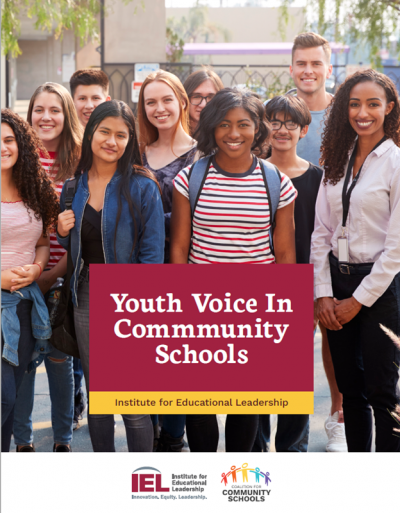
A Practical Guide to Advance Community School Strategies for Youth Voice and Leadership
About the Guide

©2024 INSTITUTE FOR EDUCATIONAL LEADERSHIP, INC. All RIGHTS RESERVED. Adaptation, replication, reproduction, and/or modifications of this Framework requires prior written approval from the Institute for Educational Leadership.
Examine the voice, engagement, and leadership of youth in Community Schools! This guide serves to support Community School practitioners to better understand and create opportunities for youth leadership in their schools and communities.
Working with participating Community Schools and students, this resource captures youth stories and insight to help illustrate how to build more inclusive decision-making and activate the next generation of leaders in our communities.
Download the guide for steps and strategies for how to incorporate youth voice, engagement, and leadership in Community Schools!
You can also access the guide without the appendix here.
Youth Voice Protocols

©2024 INSTITUTE FOR EDUCATIONAL LEADERSHIP, INC. All RIGHTS RESERVED. Adaptation, replication, reproduction, and/or modifications of these Protocols require prior written approval from the Institute for Educational Leadership.
IEL’s Coalition for Community Schools (Coalition) released a Youth Voice in Community Schools guide in the summer of 2022. The guide was designed to offer a framework for youth engagement and illuminate the voices of youth who shared vignettes of how their Community Schools meaningfully engage students in various leadership and decision-making opportunities.
To understand how the field is using this guide and offer supplemental ‘how-to’ templates, IEL, in partnership with advisory groups in local communities, co-designed a series of associated protocols that will help the field deepen practices and processes articulated in the guide. These protocols include explore, engage, co-design, implement, study, and extend stages.
This stage is a process for mapping current resources, groups, activities, and networks, as well as conducting a scan of existing student participation, with attention to inequities in access.
This stage identifies and engages existing youth leaders and adults to gain their perspectives on ongoing practices, decision-making processes, and opportunities. It also includes reaching out to the broader school community, including all students, to seek their input on the current state of decision-making processes and practices.
This stage uses existing structures, such as the Community School Council meetings, to design protocols for scaling leadership development opportunities for students and adults, with attention to disconnected students.
This stage elevates youth voice, engagement, and leadership by diversifying opportunities for authentic youth participation in various decision-making processes, including speaking at a school board meeting, testifying in front of policymakers, or developing school-based innovations. This stage promotes the practice of learned leadership skills by youth in service to both their own growth and development and systems change that centers youth voice in collaborative decision-making.
This stage underscores the power of data to inform the success of implementing new processes and practices, following participation, engagement, leadership opportunities, change in school culture, and student representation in decision-making.
This stage indicates a fundamental change in school and district policies and an extension of power in the decision-making processes to be fully inclusive of students.
This research was funded by The Annie E. Casey Foundation, Inc., and we thank them for their support;
however, the findings and conclusions presented in this report are those of the author(s) alone, and do
not necessarily reflect the opinions of the Foundation.
